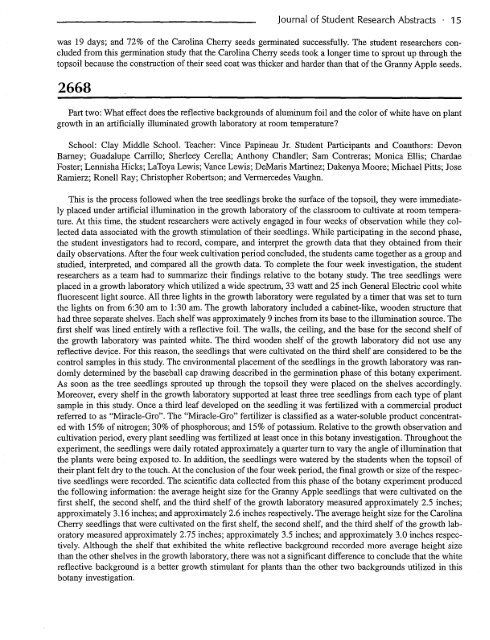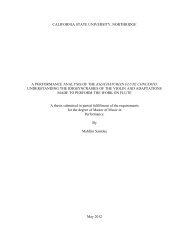2644 - CSUN ScholarWorks - California State University, Northridge
2644 - CSUN ScholarWorks - California State University, Northridge
2644 - CSUN ScholarWorks - California State University, Northridge
You also want an ePaper? Increase the reach of your titles
YUMPU automatically turns print PDFs into web optimized ePapers that Google loves.
Journal of Student Research Abstracts · 15<br />
was 19 days; and 72% of the Carolina Cherry seeds germinated successfully. The student researchers concluded<br />
from this germination study that the Carolina Cherry seeds took a longer time to sprout up through the<br />
topsoil because the construction of their seed coat was thicker and harder than that of the Granny Apple seeds.<br />
2668<br />
Part two: What effect does the reflective backgrounds of aluminum foil and the color of white have on plant<br />
growth in an artificially illuminated growth laboratory at room temperature?<br />
School: Clay Middle School. Teacher: Vince Papineau Jr. Student Participants and Coauthors: Devon<br />
Barney; Guadalupe Carrillo; Sherleey Cerelia; Anthony Chandler; Sam Contreras; Monica Ellis; Chardae<br />
Foster; Lennisha Hicks; LaToya Lewis; Vance Lewis; DeMaris Martinez; Dakenya Moore; Michael Pitts; Jose<br />
Ramierz; Ronell Ray; Christopher Robertson; and Vermercedes Vaughn.<br />
This is the process followed when the tree seedlings broke the surface of the topsoil, they were immediately<br />
placed under artificial illumination in the growth laboratory of the classroom to cultivate at room temperature.<br />
At this time, the student researchers were actively engaged in four weeks of observation while they collected<br />
data associated with the growth stimulation of their seedlings. While participating in the second phase,<br />
the student investigators had to record, compare, and interpret the growth data that they obtained from their<br />
daily observations. After the four week cultivation period concluded, the students came together as a group and<br />
studied, interpreted, and compared all the growth data. To complete the four week investigation, the student<br />
researchers as a team had to summarize their findings relative to the botany study. The tree seedlings were<br />
placed in a growth laboratory which utilized a wide spectrum, 33 watt and 25 inch General Electric cool white<br />
fluorescent light source. All three lights in the growth laboratory were regulated by a timer that was set to turn<br />
the lights on from 6:30 am to 1:30 am. The growth laboratory included a cabinet-like, wooden structure that<br />
had three separate shelves. Each shelf was approximately 9 inches from its base to the illumination source. The<br />
first shelf was lined entirely with a reflective foil. The walls, the ceiling, and the base for the second shelf of<br />
the growth laboratory was painted white. The third wooden shelf of the growth laboratory did not use any<br />
reflective device. For this reason, the seedlings that were cultivated on the third shelf are considered to be the<br />
control samples in this study. The environmental placement of the seedlings in the growth laboratory was randomly<br />
determined by the baseball cap drawing described in the germination phase of this botany experiment.<br />
As soon as the tree seedlings sprouted up through the topsoil they were placed on the shelves accordingly.<br />
Moreover, every shelf in the growth laboratory supported at least three tree seedlings from each type of plant<br />
sample in this study. Once a third leaf developed on the seedling it was fertilized with a commercial product<br />
referred to as "Miracle-Oro". The "Miracle-Gro" fertilizer is classified as a water-soluble product concentrated<br />
with 15% of nitrogen; 30% of phosphorous; and 15% of potassium. Relative to the growth observation and<br />
cultivation period, every plant seedling was fertilized at least once in this botany investigation. Throughout the<br />
experiment, the seedlings were daily rotated approximately a quarter turn to vary the angle of illumination that<br />
the plants were being exposed to. In addition, the seedlings were watered by the students when the topsoil of<br />
their plant felt dry to the touch. At the conclusion of the four week period, the final growth or size of the respective<br />
seedlings were recorded. The scientific data collected from this phase of the botany experiment produced<br />
the following information: the average height size for the Granny Apple seedlings that were cultivated on the<br />
first shelf, the second shelf, and the third shelf of the growth laboratory measured approximately 2.5 inches;<br />
approximately 3.16 inches; and approximately 2.6 inches respectively. The average height size for the Carolina<br />
Cherry seedlings that were cultivated on the first shelf, the second shelf, and the third shelf of the growth laboratory<br />
measured approximately 2.75 inches; approximately 3.5 inches; and approximately 3.0 inches respectively.<br />
Although the shelf that exhibited the white reflective background recorded more average height size<br />
than the other shelves in the growth laboratory, there was not a significant difference to conclude that the white<br />
reflective background is a better growth stimulant for plants than the other two backgrounds utilized in this<br />
botany investigation.













